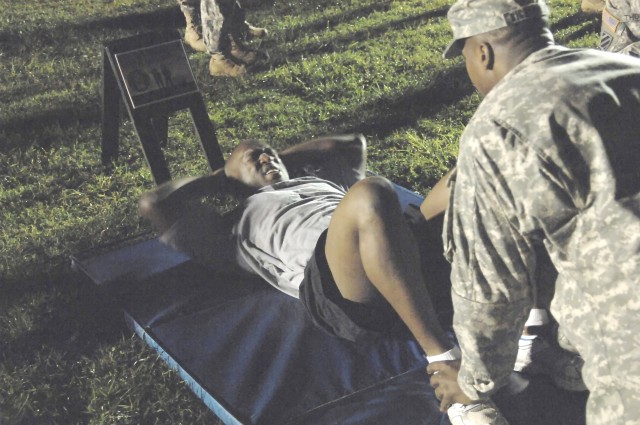Drill sergeants screaming one inch from a recruit's face. The brim of a drill's 'Smokey-the-bear' hat making a crease in the recruit's forehead. Drills encouraging responses with a sing-song "I can't hear you," followed by a chorus of "Yes, drill sergeant!"
That's the stuff of many Soldiers' fondest memories-basic training. While drill sergeants will still yell, encourage, and castigate as appropriate, some significant changes to BCT took effect this summer.
"Across the board, the mandate was to implement the changes by July 1," said Lt. Col. Christopher Willis, the commander of the 2nd Battalion, 46th Infantry Regiment. "We were a little ahead of schedule."
The changes were directed by Lt. Gen. Mark Hertling, the Training and Doctrine's Commander for Initial Military Training follwoing a process that garnered feedback from all the units that execute basic training.
"There was no grief about the changes," Lt. Col. Willis added. "Gen. Hertling brought representatives from all the (Army Training Centers), got input from all, made his decision, and then everyone bought into it.
"This was the first holistic approach to basic combat training. Since 9/11, the Army had kept adding tasks, but this review allowed us to make the training more relevant."
The Warrior Tasks and Battle Drills were changed from 15 and 62 to 15 and 4, respectively.
"Gen. Hertling's concept is to do less, but do it better," Lt. Col. Willis said.
"We now have a focus of achievable tasks," added Lt. Col. Anthony Austin, the commander of the 1st Battalion, 46th Infantry Regiment.
One of the most obvious changes to identify is the addition of one week to the training cycle, but Fort Knox units incorporated that extension last October.
"In the past, that week was used as reinforcement time; now we don't have that luxury," Lt. Col. Willis said.
Basic and advanced rifle marksmanship have been extended, increasing Soldiers-in-training time on the range from 8 hours to 50 or more so that SITs can certify their weapon expertise, explained the BCT commanders.
The changes weren't all about additions, but included some subtractions, too. Combatives time increased while bayonet training was eliminated. Although SITs won't be charging rubber tires with their bayonets affixed to weapons, they will learn more pugilism and non-lethal use of their weapons.
The combatives time has been doubled in order to train SITs to fight from their feet using kicks and strikes, not just grappling.
"Realistically, how often would you be on the ground with the enemy and not be wearing your full battle rattle'" Lt. Col. Willis said.
The combatives change means more training for drill sergeants, since a level 3 instructor is required to teach the degree of combatives with the new changes. Unfortunately, each battalion is only authorized one level three instructor.
"We really need one per company," Lt. Col. Willis said, but added that the scramble for combative instructors would level out in time as more drill sergeants attain the level 3 certification.
Another deletion from BCT is the IV stick portion of the Combat Lifesaver Course.
"They found that inserting IVs wasn't all that helpful in a combat situation," Lt. Col. Austin said. "Now more focus is placed on stopping bleeding and restoring breathing."
Physical training will now concentrate on strengthening core muscles and stamina while preventing injuries, based on the requirements of the contemporary operational environment.
In addition, the Army's new physical readiness training has been incorporated into BCT.
"It's more comprehensive," Lt. Col. Austin said. "Gen. Hertling said we're training athletes."
In addition to the Seven Army Values, more cultural education will be shared with SITs.
"We want Soldiers to understand what culture is and what yours looks like-now that you're a Soldier, not a civilian," Lt Col. Willis said. "It will also help prepare them for the cultures of Iraq or Afghanistan."
"Drill sergeants will also reinforce the culture training with real life combat experience," Lt. Col. Austin added, "making it more personal and relevant."
Soldiers will also complete the Global Assessment Tool in basic training in order to establish a baseline of resiliency that will follow them throughout their military careers. Once areas of strength and weakness are identified, Soldiers will be provided with training modules when they reach their units to help them work on their weaker areas, according to Lt. Col. Willis.
All in all, the changes seem like a good idea to the commanders.
"It's more rigorous now, and it addresses the situations Soldiers meet in combat," Lt. Col. Austin said.
There were some minor differences in the way BCT was taught at various ATCs; these changes will allow better synchronization, too, he said.


Social Sharing